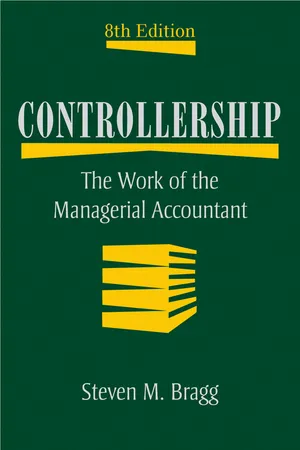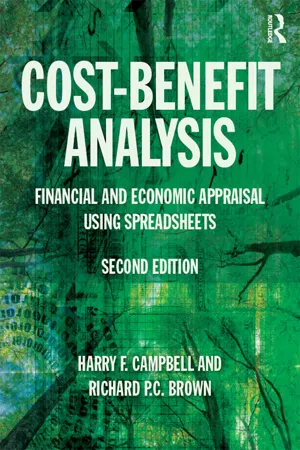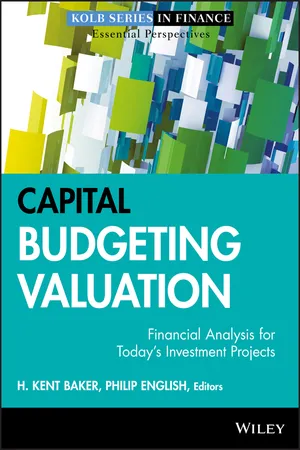Business
IRR Rule
The IRR (Internal Rate of Return) rule is a financial metric used to evaluate the profitability of potential investments. It calculates the discount rate at which the net present value of future cash flows equals zero. In essence, the IRR rule helps businesses determine the potential return on investment and compare different investment opportunities.
Written by Perlego with AI-assistance
Related key terms
10 Key excerpts on "IRR Rule"
- eBook - ePub
Finance
Capital Markets, Financial Management, and Investment Management
- Frank J. Fabozzi, Pamela Peterson Drake(Authors)
- 2009(Publication Date)
- Wiley(Publisher)
The index value is greater than one, which means that the investment produces more in terms of benefits than costs. An advantage of using the profitability index is that it translates the dollar amount of NPV into an indexed value, providing a measure of the benefit per dollar investment. This is helpful in ranking projects in cases in which the capital budget is limited.The decision rule for the profitability index depends on the PI relative to 1.0, which meansINTERNAL RATE OF RETURN
Suppose an investment opportunity requires an initial investment of $1 million and has expected cash inflows of $0.6 million after one year and another $0.6 million after two years. This opportunity is shown in Figure 14.3 using a time line.The return on this investment (denoted by internal rate of return or IRR, in the next equation) is the discount rate that causes the present values of the $0.6 million cash inflows to equal the present value of the $1 million cash outflow, calculated asAnother way to look at this is to consider the investment’s cash flows discounted at the IRR of 10%. The NPV of this project if the discount rate is 13.0662% (the IRR in this example), is zero:An investment’s internal rate of return is the discount rate that makes the present value of all expected future cash flows equal to zero. We can represent the IRR as the rate that solves Going back to Project X, the IRR for this project is the discount rate that solves Using a calculator or a computer, we get the answer of 10.172% per year.FIGURE 14.3Timeline of Investment OpportunityLooking back at the investment profiles of Projects X and Y, each profile crosses the horizontal axis (where NPV = 0) at the discount rate that corresponds to the investment’s IRR. This is no coincidence: by definition, the IRR is the discount rate that causes the project’s NPV to equal zero.The IRR is a yield—what is earned, on average, per year. How do you use it to decide which investment, if any, to choose? Let’s revisit Projects X and Y and the IRRs we just calculated for each. If, for similar risk investments, owners earn 10% per year, then both Projects X and Y are attractive. They both yield more than the rate owners require for the level of risk of these two investments: - Daniel Adrian Doss, William H. Sumrall III, Don W. Jones(Authors)
- 2017(Publication Date)
- Routledge(Publisher)
Other considerations of the IRR involve the existence of multiple instances of IRR values spawned from irregularities within cash flows through time. It is beyond the scope and magnitude of this introductory text to address such issues. However, extended discussions may be found among the writings of contemporary financial management texts.Some initiatives may require periods that are longer than those that are considered in this text. When these situations occur, it is recommended that IRR calculations be performed through the use of software spreadsheets, proprietary software, or financial calculators. Also, within the context of collegiate finance courses, a tabular solution is also available to solve IRR problems involving a variety of periods. However, for the purposes of this text, the use of the basic formula is appropriate to demonstrate the basic concept of the internal rate of return, and to delineate the calculations through which IRR problems are solved. Future editions of this text, if any, are anticipated to contain the tabular solution methods of IRR problems.7.7 Chapter Comments and Summary
This chapter introduced the internal rate of return (IRR) method of capital budgeting. The methods of capital budgeting encompass perspectives of time, cash value, rate, and profitability potential. The IRR is indicative of a rate-based perspective regarding the rendering of capital budgeting decisions. Further, the IRR method incorporates the time value of money within its primary construct. Derivation of the IRR method may occur through algebraic manipulation of the net present value formula that is given in Chapter 6 .Although the outcomes of the IRR method present quantitative findings, the outcomes must be interpreted. The rules governing the interpretation of the IRR outcome are quite basic:1. Accept the capital initiative if the value of the calculated IRR outcome is higher than the specified discount rate. 2. Reject the capital initiative if the value of the calculated IRR outcome is lower than the discount rate. 3. When the conditions of mutual exclusion govern the problem domain, select the capital initiative that demonstrates the highest IRR outcome.- eBook - ePub
Making the Compelling Business Case
Decision-Making Techniques for Successful Business Growth
- W. Messner(Author)
- 2013(Publication Date)
- Palgrave Macmillan(Publisher)
So, when is a ROI calculation useful? One can really only use the ROI method in business cases to compare the ROI of investment projects to other previous (successful) investments or with an industry average. But this is not only difficult, because as we all know from the stock market, the success rate of past investments is not a good indicator for future performance and should therefore not influence today’s decisions. And what is even more important is, as the ROI calculation formula is not uniformly defined, the business case team could run the danger of comparing apples with pears.2.5 INTERNAL RATE OF RETURN (IRR)
The internal rate of return (IRR) is a handy measure which is frequently used in finance departments. However, as the examples in this chapter will show, it can also be a very misleading metric. IRR is defined as the rate of return that makes the NPV zero. In order to find the IRR for a proposed investment, the following equation needs to be solved: There is no ambiguity in calculating the IRR for an investment that only generates one single cash flow after one period. In fact, the calculation is pretty simple:The expression for longer investment periods is much more difficult, if not impossible, to solve arithmetically and usually requires a trial-and-error linear interpolation approach, for which a spreadsheet such as the one in Figure 2.6 comes very handy.Let us revert to the previous real estate example and modify it a little: After an initial investment of $470,000 into real estate, the investor now expects a rental income of $30,000 p.a. There is a plan to sell the real estate in the fifth year for $500,000. A trial-and-error interpolation, as shown in Figure 2.9 using the NPV formula results in an IRR ≈ 6.38%, which is the rate of discount at which the investment’s NPV becomes zero (NPV - eBook - ePub
Finance for IT Decision Makers
A practical handbook
- Michael Blackstaff(Author)
- 2012(Publication Date)
- BCS, The Chartered Institute for IT(Publisher)
Project A is a proposal for a major network to improve the company’s countrywide distribution system, while Project B is a proposal to reorganise the IT supplies store. Which is now the more worthwhile?That was a ridiculously exaggerated example to make the point that reliance on percentage returns can be misleading. But therein lies what some people regard as the weakness of IRR: that it is a percentage. Others regard IRR as useful precisely because it gives a percentage result. Business people are used to results expressed as percentages. However, it would usually be wise to look at NPVs as well as IRRs as part of the decision-making process.It is now possible to formulate what we can call the ‘IRR decision rule’, which is as follows. THE IRR DECISION RULE The internal rate of return (IRR) of a proposed investment is the discount rate that, applied to its estimated cash flows, yields an NPV of exactly zero.NPV and IRR contrasted- If the IRR is greater than the company’s cost of capital, by however small a margin, then the proposed investment is, in theory, worthwhile because it would yield in real terms more than the required return on the money invested in it.
- If the IRR is less than the company’s cost of capital, by however small a margin, then the proposed investment is not worthwhile, because it would yield in real terms less than the required return on the money invested in it.
- If several mutually exclusive investments of roughly similar size are competing for the same funds, then, other things being equal, the best option financially is the one that yields the largest positive IRR.
It was asserted earlier that NPV and IRR are the two sides of one coin: discounted cash flow. It should now be clear that this is indeed the case. Here is a summary that highlights the contrast between the two: - eBook - ePub
Controllership
The Work of the Managerial Accountant
- Steven M. Bragg(Author)
- 2009(Publication Date)
- Wiley(Publisher)
Accordingly, the discounted cash flow principle has been adopted as a far superior tool in ranking and judging the profitability of the investments. The principle may be applied in two forms:- The investors’ method, also known as the internal rate of return (IRR)
- The net present value (NPV)
The first one actually involves the determination of what rate of return is estimated. The second method applies a predetermined rate, or hurdle, to the estimated stream of cash to ascertain the present value of the proposed investment.Investors’ Method: Internal Rate of Return
Technically, the rate of return on any project is that rate at which the sum of the stream of after-tax (cash) earnings, discounted yearly according to present worth, equals the cost of the project. Stating it another way, the rate of return is the maximum constant rate of return that a project could earn throughout the life of the outstanding investment and just break even.The method may be simply described by an example. Assume that an investment of $1,000 may be made and, over a five-year period, cash flow of $250 may be secured. What is the rate of return? By a cut-and-dry method, and the use of present value tables, we arrive at 8 percent. The application of the 8 percent factor to the cash flow results in a present value of approximately $1,000 is:
The proof of the computation is the determination of an 8 percent annual charge with the balance applicable to principal, just as bankers calculate rates of return.Year 8% Annual Cash Flow (a) Discount Factor (b) Present Value (a) × (b) 1 $ 250 .926 $ 232 2 250 .857 214 3 250 .794 198 4 250 .735 184 5 250 .681 170 Total present value $ 998 Year Cash Flow (A) Return at 8% of Investment Outstanding at Beginning of Year (B) Balance Applicable to Investment (C) = 5 (A − B) Outstanding Investment at Year-End (D) 0 $ — $ — $ — $1,000 1 250 80 170 830 2 250 66 184 646 3 250 52 198 448 4 250 36 214 234 5 250 19 231 3∗ ∗ Due to rounding. By trial and error, application of the proper discount factor can be explored until the proper one is found. Using a 10 percent discount factor and a 40 percent discount factor, the $1,000,000 assumed investment, discussed in connection with other evaluation methods, to be recouped over 10 years, results in a 36 percent rate of return, as shown in Exhibit 27.4 - Martin Hopkinson(Author)
- 2017(Publication Date)
- Routledge(Publisher)
Internal rate of return IRR is a discounted financial modelling measure that is often used alongside or in place of NPV forecasts. IRR is defined as being the discount rate that would result in a project NPV of zero. It is possible to calculate IRR manually in very simple cases. Excel also has an IRR function. However, the usual procedure for obtaining IRR is to create an NPV model and use trial and error to determine the discount rate that results in an NPV that is sufficiently close to zero for the level of accuracy that is appropriate. As an example, the IRR for Model 2.2 is approximately 17%. A similar procedure can be employed with NPV risk models, using the mean NPV forecast equal to zero as the basis for obtaining the IRR.Organisations using IRR usually specify a hurdle rate for projects that must be exceeded in order for them to be approved. If this practice is intended to be consistent with the NPV rule, then the hurdle would be set at the relevant discount rate. However, organisations often choose to set a higher hurdle than this on the grounds of reluctance to accept the risk of proceeding with projects with business cases that are only marginal. Whilst this way of thinking is understandable, it can also be interpreted as being a form of blanket discount rate adjustment which, for reasons described earlier in this chapter, may have counterproductive effects.The advantage of IRR over NPV is that IRR is independent of project size. If, for example, you take any NPV model and double each cost and benefit input, you would double the NPV, but the IRR would remain constant. IRR can thus be a useful measure to report alongside NPV forecasts for large projects that appear to be attractive from an NPV perspective but are exposed as being marginal by their IRR.A perception that IRR provides a clearer comparison between projects than NPV is probably the most important cause of its widespread use. Unfortunately, the technique has limitations which, unless recognised, can lead to errors in project selection, particularly when relatively unusual cash flow patterns are involved. Brealey, Myers and Allen (2014) provide a good illustration of the types of circumstance in which the NPV and IRR measures can lead to contradictory evidence. Whereas NPV forecasts are based on today’s value of cash, and can thus be used as a rational basis for choice, IRR does not behave in a similarly consistent manner. A key conclusion from this is that IRR should not be used to choose between mutually exclusive options. When comparing different options for the same project the use of IRR would thus be incorrect.- eBook - ePub
Cost-Benefit Analysis
Financial And Economic Appraisal Using Spreadsheets
- Harry F. Campbell, Richard P.C. Brown(Authors)
- 2015(Publication Date)
- Routledge(Publisher)
Figure 2.5 Net present value in relation to the discount rate. The present value of a net benefit stream (NPV) falls as the discount rate is increased. The discount rate which makes the NPV zero is termed the internal rate of return (IRR).It was explained earlier that the internal rate of return, rp , is the discount rate which reduces the project’s NPV to zero, as denoted by IRR in Figure 2.5 . It can be calculated by solving the following equation for rp :Multiplying both sides of this equation by (1 + rp )2 gives an equation of the following form:−Kx2 + B1 x + B2 = 0where x = (1 + rp ). This is the familiar quadratic form, as illustrated in Figure 2.6 , which can be solved for x and then for rp .More generally, it can be noted that if we extended the analysis to include a benefit at time 3, we would need to solve a cubic equation, and if we further extended it to time 4, it would be a quartic equation, and so on; fortunately we will be solving only a couple of IRR problems by hand – the rest will be done by computer using a spreadsheet function.To return to our example, we need to solve:F(x) = −1.6x2 + 10x + 10 = 0which is a quadratic equation of the general form:Figure 2.6Calculating internal rates of return: one positive value. The equation: F(x) = −Kx2 + B1 x + B2 = 0 has two solutions for x, where x represents (1 + rp ). The negative solution can be ignored. The positive solution indicates that 1 + rp = 7.13. In other words, the internal rate of return, rp , is 613%.F(x) = ax2 + bx + c = 0where a = −1.6, b =10, and c =10, and which has two solutions given by the formula:A bit of arithmetic gives us the solution values 7.13 and –0.88, which is where the function crosses the x-axis as illustrated in Figure 2.6 . This means that rp is either 6.13 (613%) or –1.88 (–188%). The negative solution has no meaning in the context of project appraisal and is discarded. Hence the IRR is 613%, which is very healthy compared with an interest rate of 10%.Let us now change the example by making B2 = −10. For example, the project could be a mine which involves an initial establishment cost and a land rehabilitation cost at the end of the project’s life. When we calculate the IRR using the above method, we find that there are two solutions as before, but that they are both positive: rp - eBook - ePub
- E.J. Mishan, Euston Quah(Authors)
- 2020(Publication Date)
- Routledge(Publisher)
outlay of 121 at the end of the second year – thus an investment stream equal to −100, 220, −121 – a discount rate equal to 10 per cent, reduces the present value of that stream to zero. The IRR is, therefore, equal to 10 per cent.Inasmuch, then, as in conforming to the formula, both outlays and benefits are to be discounted to the present at the IRR, it will sometimes be neater to obviate mention of the initial outlay K and any subsequent outlays, treating them instead as negative net benefits in the year they occur. The formula then becomesin which B t can be positive, negative or zero∑t = 0n= 0 ,B t1 + λtIt will be convenient, henceforth to continue using negative B s for any subsequent outlays. Nonetheless, it should be understood that, although there can also be negative net benefits in future years that are in fact not cash outlays, being instead possible losses arising from environmental damage or compensatory payment, it makes no difference in the calculation of the IRR – or, for that matter, of the DPV, given the discount rate.13 The sense in which the internal rate of return, so defined, is an average over time is conveyed by the example of a man investing, say, 100 for five years. If the internal rate of return of some given investment stream were 25 per cent per annum, the man would have in mind an equivalent , though simpler, investment in which his 100 in the present grows by 25 per cent each year. He sees his 100 in the present becoming 125 by the end of the first year,156.25by the end of the second year, and so on, to reach 100(1 + 0.25)5 by the end of the fifth year. More generally, if the investment stream in question were −100, B 1 , B 2 , B 3 , B 4 , B 5 , where the B s are any pattern of benefits, and the internal rate of return were known to be 25 per cent, then an equivalent investment stream would be −100,0,0,0,0, 100[(1 + 0.25)5 ], for this given investment stream, when discounted to its present value at 25 per cent, is, by assumption, equal to zero, and so also is the equivalent stream. Consequently, if a man is told that the internal rate of an investment stream over n years is equal to λ, he is justified in thinking of the investment as equivalent to one in which his initial outlay is compounded forward at the rate of λ per annum for n - eBook - ePub
Multiple Interest Rate Analysis
Theory and Applications
- M. Osborne(Author)
- 2014(Publication Date)
- Palgrave Pivot(Publisher)
et al . (2011) contains a classic statement of the arguments and lists four pitfalls.1 An IRR, by itself, does not indicate whether a project involves borrowing or lending;2 Some cash flows cause the IRR equation to solve for more than one plausible IRR, resulting in ambiguity about which IRR to use as a criterion;3 NPV and IRR do not always rank mutually exclusive projects the same; the consensus opinion is that ranking by NPV is reliable, and therefore ranking by IRR is not;4 A non-flat yield curve provides more than one cost of capital with which to compare IRR leading to uncertainty about which cost of capital to employ.Despite the pitfalls there is considerable empirical evidence that the majority of practitioners continue to use IRR as an investment criterion and performance measure. For example, in the context of capital budgeting there is the study of US data by Graham and Harvey (2001) and the similarly executed study of European data by Brounen et al . (2004). Many studies of capital budgeting practice are published every year containing similar results for various countries. In the context of IRR as a performance measure for private equity firms, hedge funds, and venture capitalists see the works by Phalippou (2008), Phalippou and Gottschalg (2009), Dichev and Yu (2011), and Achleitner et al. - eBook - ePub
Capital Budgeting Valuation
Financial Analysis for Today's Investment Projects
- H. Kent Baker, Philip English, H. Kent Baker, Philip English(Authors)
- 2011(Publication Date)
- Wiley(Publisher)
Whether companies actually follow or maintain such a policy is questionable. Further, using a single rate for all cash flows no matter when the cash flows occur in the future is an issue within an NPV analysis as discussed in Chapter 4. Leaving such issues aside, a similar claim of the firm maintaining a constant reinvestment rate cannot be made with an IRR analysis. Future projects having the same IRR as current projects is an unlikely scenario. Such a scenario cannot be the by-product of company policy to maintain a particular debt and equity mix yielding a stable NPV discount rate. A particular debt and equity mix could maintain a specific weighted average cost of capital (WACC), which analysts could use as the RADR within an NPV analysis.As stated earlier, IRR is the discount rate that sets NPV to zero, but it cannot be precisely interpreted as the actual return generated by the project. To illustrate the issue, use one of the projects from the previous section: initial cost of $10,000 followed by four annual cash inflows of $3,500 beginning next year. The project's IRR is 14.963 percent, but assuming the firm can reinvest intermediate cash flows at 10 percent annually, what is the actual return on the project? The four cash inflows at the end of the project are worth $16,243.50 (=$3,500.00((1.10)4 − 1)/0.10), making the annual return on the project 12.894 percent (=(($16,243.50/$10,000.00)0.25 − 1). Notice that the project's actual return is lower than the IRR. If the reinvestment rate were 14.963 percent (i.e., equal to the IRR) instead of 10 percent, the actual return would be equal to the IRR.Assuming the above discussion convinces a decision maker to consider reinvestment rates (Solomon, 1956; Renshaw, 1957; Teichroew, Robichek, and Montalbano, 1965a, 1965b; Dudley, 1972; Dorfman, 1981), Marglin (1963) offers the following question: What reinvestment rate should be used? Solomon suggests an opportunity cost expressed as a rate for the reinvestment rate and concludes that the reinvestment rate should be the firm's cost of capital. The only cost to be considered is the initial cost and all the following cash flows accrue interest at the cost of capital until the project ends. The terminal value of all the cash flows with interest is then compared to the initial cost to find a holding period return that is compared to a hurdle rate. This process is exactly what is performed previously, assuming that 10 percent is the cost of capital (reinvestment rate) to find the project return of 12.894 percent and is a variant of what Lin (1976) calls the modified internal rate of return (MIRR).
Index pages curate the most relevant extracts from our library of academic textbooks. They’ve been created using an in-house natural language model (NLM), each adding context and meaning to key research topics.









